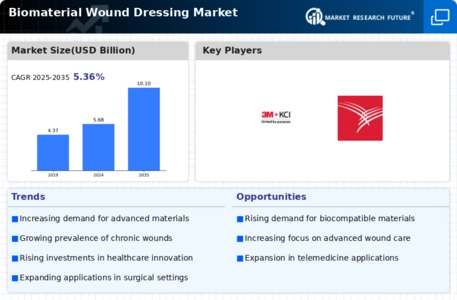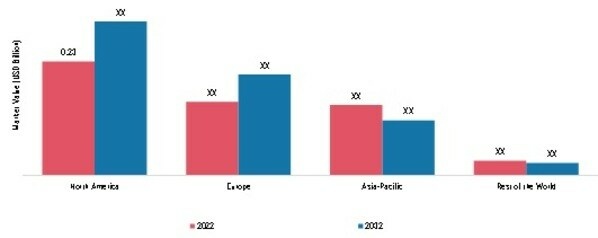Market Trends
Introduction
The biomaterial wound dressing market is witnessing major changes, owing to the confluence of macro and micro factors. The advancement of biomaterials is leading to greater efficacy and versatility of wound dressings, while the regulatory pressure is driving them to higher standards of safety and effectiveness. The growing preference for advanced wound care solutions is also changing the market dynamics. These factors are of great importance for market participants, as they not only drive product development and innovation, but also determine the positioning of companies in the increasingly complex healthcare environment.
Top Trends
-
Increased Adoption of Advanced Biomaterials
In the field of medical technology, the transition to advanced biomaterials, such as hydrogels and nanofibres, is being driven by companies such as 3M and Mölnlycke Health Care. These materials retain more moisture and promote faster healing, with studies indicating a reduction in healing time of up to 30 per cent. This trend will result in a higher level of innovation, and therefore increased competition and market share for the market leaders. -
Integration of Smart Technology
Smart dressings with sensors for monitoring the healing process are gaining ground, as Acelity and ConvaTec are showing. These systems can provide real-time data and, according to clinical trials, can improve the clinical outcome by up to 25 per cent. Among the operational effects are fewer hospital visits, which in turn will encourage further investment in smart solutions. -
Sustainability and Eco-Friendly Materials
The demand for sustainable wound dressings is increasing, and companies like Coloplast are working with biodegradable materials. A survey shows that more than 70 per cent of consumers prefer eco-friendly products, which affects purchasing decisions. This trend will probably drive the industry towards greener production methods and reshape the supply chain. -
Regulatory Support for Innovative Products
Regulations are increasingly encouraging the development of wound care solutions. Regulatory approvals for new dressings are now granted in a much shorter time. For example, the US Food and Drug Administration (FDA) has accelerated the approval process for smart dressings by 40 percent. The regulatory environment thus encourages investment in new technology, thereby creating a more dynamic market. -
Rise in Chronic Wound Incidence
Among the aging population, the number of chronic wounds is increasing, and the demand for special dressings is growing. There are 6.5 million patients in the US alone, and companies are now developing targeted solutions. The trend towards a greater focus on chronic care and specialized therapies is likely to continue. -
Telehealth Integration in Wound Care
Among these companies, Cardinal Health has integrated telehealth into its wound-care management. It is estimated that telehealth can reduce the cost of care by up to 20 percent while improving the care of the patient. This trend is expected to improve the service models of health care institutions and to create new sources of income for these institutions. -
Focus on Personalized Medicine
A new kind of wound dressing is emerging, with companies developing wound dressings that are adapted to individual patient needs. Research has shown that this kind of individualized treatment can improve healing by as much as 35%. This development will probably lead to an increase in the number of products that are developed and launched, but it will also require companies to invest in research and development and in personalization. -
Expansion of E-commerce Channels
The development of the e-business platform for wound care products is transforming the distribution strategies of the industry, as seen in the case of Derma Sciences. Sales on the e-business platform have increased by more than 50% in recent years, mainly driven by the convenience of consumers. This trend has prompted traditional retailers to change their strategies, resulting in a more competitive e-business platform. -
Increased Investment in R&D
The leading players have significantly increased their R&D expenditures, focusing on the development of new wound dressings. For example, Medtronic has devoted considerable resources to biomaterials innovation. This trend will accelerate product development cycles, which will strengthen the market's overall competitiveness. -
Collaboration and Partnerships
Strategic alliances between industry and research institutions are increasing. This is an important source of innovation. This development will lead to the sharing of knowledge and the rapid development of products.
Conclusion: Navigating the Biomaterial Wound Dressing Landscape
As we approach 2025, the Biomaterials Wound Dressings Market is characterized by intense competition and notable fragmentation, with both established and new players fighting for market share. The growing emphasis on the use of advanced and sustainable materials is encouraging suppliers to continue their innovation. The established players are focusing on the use of their established distribution channels and their brand name. The new players are concentrating on the use of new technology, such as artificial intelligence and automation, to enhance the performance and efficiency of their products and processes. The ability to adapt to the market’s needs through the use of flexible and sustainable practices will be critical to securing leadership in this market. Strategic decision-makers need to make sure that they are investing in these capabilities to maintain a competitive edge and to respond effectively to changing regulations and preferences.






Leave a Comment